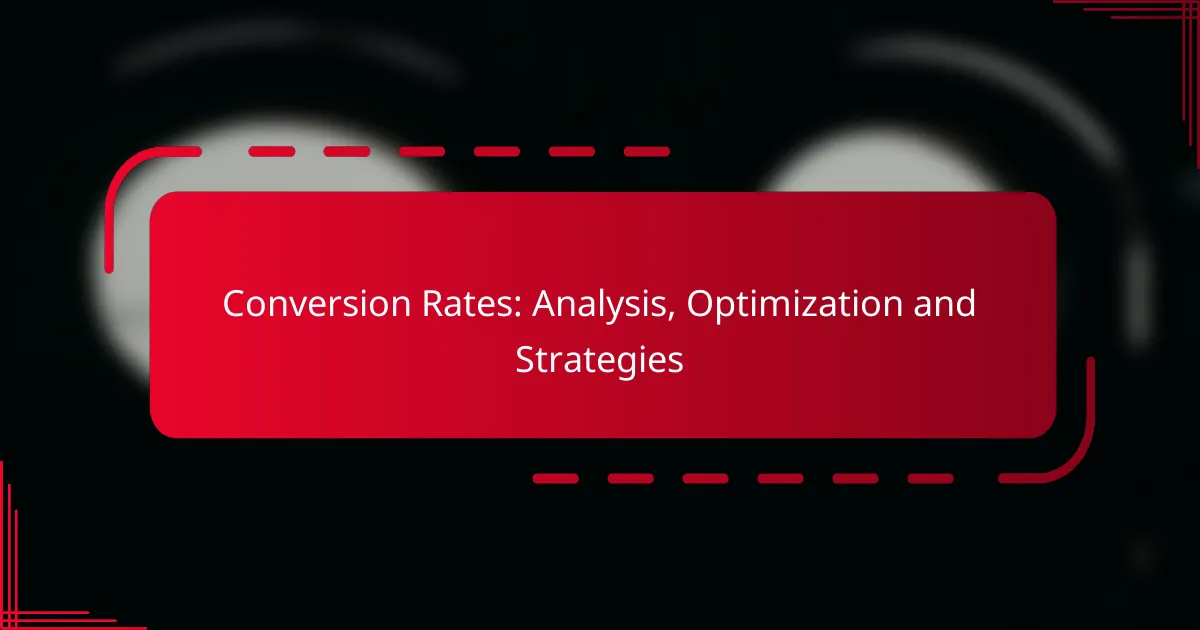Understanding and improving conversion rates is crucial for maximizing the effectiveness of marketing efforts and achieving business success. By analyzing user behavior and campaign performance, businesses can identify key areas for optimization, ensuring that their strategies are both targeted and effective. Avoiding common pitfalls in conversion rate optimization is essential for turning visitors into loyal customers.

How can you improve conversion rates in display advertising?
Improving conversion rates in display advertising involves a combination of targeting the right audience, creating engaging ad content, and optimizing user experience. By focusing on these areas, advertisers can significantly enhance their effectiveness and return on investment.
Targeted audience segmentation
Targeted audience segmentation is crucial for improving conversion rates. By dividing your audience into specific groups based on demographics, interests, or behaviors, you can tailor your ads to resonate more effectively with each segment. For example, a fashion retailer might target young adults with trendy styles while focusing on older consumers with classic options.
Utilizing tools like Google Analytics or Facebook Audience Insights can help identify these segments. Aim to create at least three to five distinct audience profiles to maximize your ad relevance and engagement.
Compelling ad creatives
Compelling ad creatives are essential for capturing attention and driving conversions. This includes eye-catching visuals, clear messaging, and a strong call to action. For instance, using vibrant colors and bold fonts can draw users in, while concise text can effectively communicate the value proposition.
Consider testing different formats, such as static images, videos, or interactive ads, to see which performs best with your audience. A/B testing can help identify the most effective creative elements, allowing you to refine your approach over time.
A/B testing strategies
A/B testing strategies are vital for optimizing display ads. This method involves creating two variations of an ad and measuring their performance to determine which one yields better conversion rates. Key elements to test include headlines, images, and calls to action.
When conducting A/B tests, ensure you have a clear hypothesis and sufficient traffic to achieve statistically significant results. Aim to run tests for at least one to two weeks to account for variations in user behavior.
Optimizing landing pages
Optimizing landing pages is critical for converting clicks into actions. A well-designed landing page should align with the ad’s message and provide a seamless user experience. Key elements include fast loading times, mobile responsiveness, and clear navigation.
Incorporate strong calls to action and minimize distractions by limiting the number of links or options available. Regularly review analytics to identify areas for improvement, such as high bounce rates or low engagement times.
Utilizing retargeting techniques
Utilizing retargeting techniques can significantly boost conversion rates by reminding users of products or services they previously viewed. This strategy keeps your brand top-of-mind and encourages potential customers to return and complete their purchase.
Implement retargeting ads across various platforms, such as social media and search engines, to reach users where they are most active. Consider segmenting your retargeting audience based on their behavior, such as those who added items to their cart but did not complete the checkout process.

What metrics should you analyze for conversion rate optimization?
To effectively optimize conversion rates, focus on key metrics that reveal user behavior and campaign performance. Analyzing these metrics helps identify areas for improvement and informs strategic decisions to enhance overall conversion rates.
Click-through rate (CTR)
Click-through rate (CTR) measures the percentage of users who click on a specific link compared to the total number of users who view the page or ad. A higher CTR indicates that your content is engaging and relevant to your audience.
To improve CTR, consider optimizing your headlines, using compelling calls to action, and ensuring your ads are targeted to the right audience. Regularly testing different approaches can help you find what resonates best.
Bounce rate
Bounce rate is the percentage of visitors who leave your site after viewing only one page. A high bounce rate may suggest that your landing pages are not meeting user expectations or that the traffic source is misaligned with your content.
To reduce bounce rates, ensure your landing pages are relevant, load quickly, and provide clear navigation. Analyzing user behavior through heatmaps can also help you identify areas for improvement.
Cost per acquisition (CPA)
Cost per acquisition (CPA) calculates the total cost of acquiring a customer through your marketing efforts. This metric helps you understand the effectiveness of your campaigns and whether your spending aligns with your revenue goals.
To optimize CPA, focus on refining your targeting strategies and improving your conversion funnel. Regularly review your ad spend and adjust your campaigns based on performance to ensure you are maximizing your return on investment.
Return on ad spend (ROAS)
Return on ad spend (ROAS) measures the revenue generated for every dollar spent on advertising. A higher ROAS indicates a more effective advertising strategy and helps you gauge the profitability of your campaigns.
To enhance ROAS, analyze which channels and campaigns yield the best results, and allocate more budget to those areas. Testing different ad creatives and targeting options can also help improve your overall return.

What are common pitfalls in conversion rate optimization?
Common pitfalls in conversion rate optimization (CRO) can significantly hinder a website’s effectiveness in converting visitors into customers. Recognizing and avoiding these mistakes is essential for improving conversion rates and achieving business goals.
Ignoring mobile optimization
Ignoring mobile optimization can lead to a poor user experience for a significant portion of your audience. With mobile devices accounting for a large share of web traffic, websites that are not mobile-friendly may see higher bounce rates and lower conversions.
To optimize for mobile, ensure your site is responsive, loads quickly, and features easy navigation. Consider testing your site on various devices to identify and fix issues that could deter mobile users.
Overcomplicating user experience
Overcomplicating the user experience can confuse visitors and drive them away. A cluttered layout, excessive options, or unclear calls to action can overwhelm users, making it difficult for them to complete desired actions.
Simplify the user journey by streamlining navigation, minimizing distractions, and clearly highlighting key actions. Aim for a clean design that guides users effortlessly toward conversion points.
Neglecting data analysis
Neglecting data analysis can prevent you from understanding user behavior and optimizing effectively. Without analyzing metrics such as bounce rates, click-through rates, and conversion paths, you may miss critical insights that inform your CRO strategy.
Regularly review analytics data to identify trends and areas for improvement. Use A/B testing to experiment with different elements and measure their impact on conversion rates, allowing for informed adjustments based on real user feedback.

What tools can assist in conversion rate analysis?
Several tools can enhance conversion rate analysis by providing insights into user behavior and website performance. Utilizing these tools can help identify areas for improvement and optimize the user experience to boost conversion rates.
Google Analytics
Google Analytics is a powerful tool that tracks website traffic and user interactions. It offers detailed reports on user demographics, behavior flow, and conversion tracking, allowing businesses to analyze which channels drive the most conversions.
To effectively use Google Analytics for conversion rate analysis, set up goals that align with your business objectives. Regularly review the conversion rates for different traffic sources to identify high-performing channels and areas needing improvement.
Hotjar
Hotjar provides insights into user behavior through heatmaps, session recordings, and feedback polls. These features allow you to visualize how users interact with your site, helping to pinpoint issues that may hinder conversions.
Utilizing Hotjar’s heatmaps can reveal which sections of your site attract the most attention, while session recordings can help you understand user frustrations. This qualitative data complements quantitative metrics from tools like Google Analytics.
Optimizely
Optimizely is an experimentation platform that enables A/B testing to optimize conversion rates. By testing different variations of your website, you can determine which elements resonate best with your audience and drive higher conversions.
When using Optimizely, focus on testing significant changes that could impact user experience, such as call-to-action buttons or landing page layouts. Monitor the results closely to ensure that your optimizations lead to meaningful improvements in conversion rates.

How does user experience impact conversion rates?
User experience significantly affects conversion rates by influencing how easily visitors can navigate a website and complete desired actions. A positive experience can lead to higher engagement and increased sales, while a poor experience often results in high bounce rates and lost opportunities.
Importance of site speed
Site speed is crucial for retaining visitors and enhancing conversion rates. Research indicates that even a delay of a few seconds can lead to a substantial drop in user satisfaction and engagement. Aim for page load times under three seconds to keep users engaged.
To optimize site speed, consider compressing images, minimizing code, and utilizing content delivery networks (CDNs). Regularly test your site’s performance using tools like Google PageSpeed Insights to identify areas for improvement.
Navigation simplicity
Simplified navigation helps users find what they need quickly, which can directly boost conversion rates. Clear menus, logical categorization, and a straightforward layout reduce frustration and encourage users to explore further.
Implement intuitive design principles, such as limiting menu items to seven or fewer and ensuring that important pages are no more than three clicks away. Regularly gather user feedback to identify navigation pain points and make necessary adjustments.
